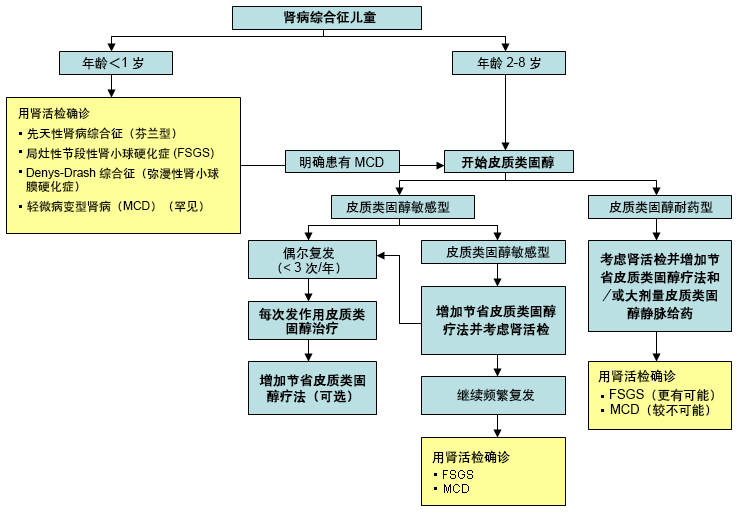初期表现
皮质类固醇治疗被认为是主要的治疗手段并用于所有患者。在20世纪 70 年代标志性的试验中,由于国际儿童肾脏病研究 (ISKDC) 的努力,肯定了皮质类固醇治疗在 MCD 中的初始作用。[1]Gordillo R, Spitzer A. The nephrotic syndrome. Pediatr Rev. 2009;30:94-104.http://www.ncbi.nlm.nih.gov/pubmed/19255123?tool=bestpractice.com肾病综合征 (NS) 儿童中约85%对皮质类固醇治疗有反应。在活检中有微小病变组织学的儿童中,94% 对皮质类固醇治疗有反应。[1]Gordillo R, Spitzer A. The nephrotic syndrome. Pediatr Rev. 2009;30:94-104.http://www.ncbi.nlm.nih.gov/pubmed/19255123?tool=bestpractice.com
虽然最初的治疗方法大部分保持未变,但最近研究人员认为较长疗程的泼尼松龙(泼尼松)疗法优于原来使用的方案。[24]Ehrich JH, Brodehl J. Long versus standard prednisone therapy for initial treatment of idiopathic nephrotic syndrome in children. Arbeitsgemeinschaft fur Padiatrische Nephrologie. Eur J Pediatr. 1993;152:357-361.http://www.ncbi.nlm.nih.gov/pubmed/8482290?tool=bestpractice.com降低复发率:有中等质量的证据表明,较长疗程的泼尼松龙(泼尼松)治疗(60 mg/m2体表面积,每日口服,连服 6 周,然后 40 mg/m2体表面积,隔日口服,连服 6 周)对皮质类固醇敏感型肾病综合征的表现优于标准治疗方案(60 mg/m2体表面积,每日口服,连服 4 周,然后 40 mg/m2 体表面积,隔日口服,连服 4 周),因为它降低了随后的复发率,但没有增加严重皮质类固醇不良反应的风险。[24]Ehrich JH, Brodehl J. Long versus standard prednisone therapy for initial treatment of idiopathic nephrotic syndrome in children. Arbeitsgemeinschaft fur Padiatrische Nephrologie. Eur J Pediatr. 1993;152:357-361.http://www.ncbi.nlm.nih.gov/pubmed/8482290?tool=bestpractice.com受试者<200名的随机对照临床试验(RCT)、受试者>200名且方法学存在缺陷的随机对照临床试验(RCT)、方法学存在缺陷的系统评价或者高质量的观察性(队列)研究。首次发作时延长疗程可达到持续性缓解并减少复发的频率。[24]Ehrich JH, Brodehl J. Long versus standard prednisone therapy for initial treatment of idiopathic nephrotic syndrome in children. Arbeitsgemeinschaft fur Padiatrische Nephrologie. Eur J Pediatr. 1993;152:357-361.http://www.ncbi.nlm.nih.gov/pubmed/8482290?tool=bestpractice.com
如果在治疗 4 周后仍无反应,则应考虑为抗皮质类固醇型 NS。在这组患者中可考虑静脉使用大剂量皮质类固醇。一些医生选择在开始免疫抑制剂治疗之前进行肾活组织检查以证实组织学诊断,而另一些医生则在考虑活检之前进行试验性治疗。
在过去的十年中,皮质类固醇耐药型 NS 的治疗已经有了改善,但仍然具有挑战性。大多数患者不能保持无蛋白尿,并可呈进行性肾损害。添加钙调磷酸酶抑制剂如环孢素(环孢菌素)或他克莫司能增强这些患者的缓解率。[25]Bagga A, Mantan M. Nephrotic syndrome in children. Indian J Med Res. 2005;122:13-28.http://www.icmr.nic.in/ijmr/2005/july/0701.pdfhttp://www.ncbi.nlm.nih.gov/pubmed/16106086?tool=bestpractice.com[26]Colquitt JL, Kirby J, Green C, et al. The clinical effectiveness and cost-effectiveness of treatments for children with idiopathic corticosteroid-resistant nephrotic syndrome: a systematic review. Health Technol Assess. 2007;11:iii-iv, ix-xi, 1-93.http://www.journalslibrary.nihr.ac.uk/hta/volume-11/issue-21http://www.ncbi.nlm.nih.gov/pubmed/17537341?tool=bestpractice.com[27]Bock ME, Cohn RA, Ali FN. Treatment of childhood nephrotic syndrome with long-term, low-dose tacrolimus. Clin Nephrol. 2013;79:432-438.http://www.ncbi.nlm.nih.gov/pubmed/23380387?tool=bestpractice.com[28]Hamasaki Y, Yoshikawa N, Nakazato H, et al. Prospective 5-year follow-up of cyclosporine treatment in children with steroid-resistant nephrosis. Pediatr Nephrol. 2013;28:765-771.http://www.ncbi.nlm.nih.gov/pubmed/23314441?tool=bestpractice.com他克莫司因为更低的复发风险和没有美容方面的不良反应,成为环孢素有前途的替代品。[25]Bagga A, Mantan M. Nephrotic syndrome in children. Indian J Med Res. 2005;122:13-28.http://www.icmr.nic.in/ijmr/2005/july/0701.pdfhttp://www.ncbi.nlm.nih.gov/pubmed/16106086?tool=bestpractice.com[26]Colquitt JL, Kirby J, Green C, et al. The clinical effectiveness and cost-effectiveness of treatments for children with idiopathic corticosteroid-resistant nephrotic syndrome: a systematic review. Health Technol Assess. 2007;11:iii-iv, ix-xi, 1-93.http://www.journalslibrary.nihr.ac.uk/hta/volume-11/issue-21http://www.ncbi.nlm.nih.gov/pubmed/17537341?tool=bestpractice.com[27]Bock ME, Cohn RA, Ali FN. Treatment of childhood nephrotic syndrome with long-term, low-dose tacrolimus. Clin Nephrol. 2013;79:432-438.http://www.ncbi.nlm.nih.gov/pubmed/23380387?tool=bestpractice.com缓解:有高质量的证据表明,他克莫司或环孢素(环孢菌素)联合皮质类固醇对皮质类固醇耐药型肾病综合征患者诱导缓解有相似疗效。[25]Bagga A, Mantan M. Nephrotic syndrome in children. Indian J Med Res. 2005;122:13-28.http://www.icmr.nic.in/ijmr/2005/july/0701.pdfhttp://www.ncbi.nlm.nih.gov/pubmed/16106086?tool=bestpractice.com[26]Colquitt JL, Kirby J, Green C, et al. The clinical effectiveness and cost-effectiveness of treatments for children with idiopathic corticosteroid-resistant nephrotic syndrome: a systematic review. Health Technol Assess. 2007;11:iii-iv, ix-xi, 1-93.http://www.journalslibrary.nihr.ac.uk/hta/volume-11/issue-21http://www.ncbi.nlm.nih.gov/pubmed/17537341?tool=bestpractice.com系统评价或者受试者>200名的随机对照临床试验(RCT)。
为应对皮质类固醇引起的骨质疏松症,许多临床医生开始对应用皮质类固醇治疗的患者进行补钙。[1]Gordillo R, Spitzer A. The nephrotic syndrome. Pediatr Rev. 2009;30:94-104.http://www.ncbi.nlm.nih.gov/pubmed/19255123?tool=bestpractice.com[2]Eddy AA, Symons JM. Nephrotic syndrome in childhood. Lancet. 2003;362:629-639.http://www.ncbi.nlm.nih.gov/pubmed/12944064?tool=bestpractice.com[3]Schlesinger ER, Sultz HA, Mosher WE, et al. The nephrotic syndrome: its incidence and implications for the community. Am J Dis Child. 1968;116:623-632.http://www.ncbi.nlm.nih.gov/pubmed/5697193?tool=bestpractice.com维生素 D 也被用于辅助补钙以防止因皮质类固醇造成的骨质疏松。[1]Gordillo R, Spitzer A. The nephrotic syndrome. Pediatr Rev. 2009;30:94-104.http://www.ncbi.nlm.nih.gov/pubmed/19255123?tool=bestpractice.com[2]Eddy AA, Symons JM. Nephrotic syndrome in childhood. Lancet. 2003;362:629-639.http://www.ncbi.nlm.nih.gov/pubmed/12944064?tool=bestpractice.com[3]Schlesinger ER, Sultz HA, Mosher WE, et al. The nephrotic syndrome: its incidence and implications for the community. Am J Dis Child. 1968;116:623-632.http://www.ncbi.nlm.nih.gov/pubmed/5697193?tool=bestpractice.com
复发
复发是蛋白尿再现 3 d或更多天,伴或不伴水肿、低白蛋白血症和高脂血症。最近诊断复发的患者采用类似于初次发病时的治疗,但当无蛋白尿达到 3 d时通常转换为更低的皮质类固醇剂量。然后逐渐减少或维持此剂量数周,这取决于患者复发和皮质类固醇不良反应发生率的病史。
对于频繁复发的 NS(6 个月内发病>2 次,或者 1 年内发病 3 次或以上)和皮质类固醇依赖(皮质类固醇减量过程中复发)患者,建议采用皮质类固醇减量疗法。[25]Bagga A, Mantan M. Nephrotic syndrome in children. Indian J Med Res. 2005;122:13-28.http://www.icmr.nic.in/ijmr/2005/july/0701.pdfhttp://www.ncbi.nlm.nih.gov/pubmed/16106086?tool=bestpractice.com[26]Colquitt JL, Kirby J, Green C, et al. The clinical effectiveness and cost-effectiveness of treatments for children with idiopathic corticosteroid-resistant nephrotic syndrome: a systematic review. Health Technol Assess. 2007;11:iii-iv, ix-xi, 1-93.http://www.journalslibrary.nihr.ac.uk/hta/volume-11/issue-21http://www.ncbi.nlm.nih.gov/pubmed/17537341?tool=bestpractice.com[27]Bock ME, Cohn RA, Ali FN. Treatment of childhood nephrotic syndrome with long-term, low-dose tacrolimus. Clin Nephrol. 2013;79:432-438.http://www.ncbi.nlm.nih.gov/pubmed/23380387?tool=bestpractice.com对于间歇性复发患者(每年发病<3 次),也可以考虑皮质类固醇减量疗法。此外,还应用以下药物之一治疗:环磷酰胺、环孢素、他克莫司或麦考酚酯。也可应用左旋咪唑。
如果尽管已采用皮质类固醇减量疗法,但仍频繁复发,则应进行肾活组织检查以确认病理诊断。一些医生更喜欢在增加免疫抑制剂治疗前进行肾活检。
水肿的管理
水肿管理主要包括低盐饮食和限制液体的摄入量。[1]Gordillo R, Spitzer A. The nephrotic syndrome. Pediatr Rev. 2009;30:94-104.http://www.ncbi.nlm.nih.gov/pubmed/19255123?tool=bestpractice.com[2]Eddy AA, Symons JM. Nephrotic syndrome in childhood. Lancet. 2003;362:629-639.http://www.ncbi.nlm.nih.gov/pubmed/12944064?tool=bestpractice.com根据 MCD 的阶段、低蛋白血症的进展率和血浆膨胀压的绝对水平,功能性低血容量可能会发展,这将刺激止血机制和继发性药物性钠潴留。[29]Haws RM, Baum M. Efficacy of albumin and diuretic therapy in children with nephrotic syndrome. Pediatrics. 1993;91:1142-1146.http://www.ncbi.nlm.nih.gov/pubmed/8502517?tool=bestpractice.com液体限制相当于每日排出量加上不显性失水量。[1]Gordillo R, Spitzer A. The nephrotic syndrome. Pediatr Rev. 2009;30:94-104.http://www.ncbi.nlm.nih.gov/pubmed/19255123?tool=bestpractice.com
出现大面积全身水肿或明显呼吸窘迫时,应考虑使用白蛋白和呋塞米。[29]Haws RM, Baum M. Efficacy of albumin and diuretic therapy in children with nephrotic syndrome. Pediatrics. 1993;91:1142-1146.http://www.ncbi.nlm.nih.gov/pubmed/8502517?tool=bestpractice.com同时,每次输注白蛋白时应静脉给药呋塞米,以促进排尿。[29]Haws RM, Baum M. Efficacy of albumin and diuretic therapy in children with nephrotic syndrome. Pediatrics. 1993;91:1142-1146.http://www.ncbi.nlm.nih.gov/pubmed/8502517?tool=bestpractice.com在输注过程中,应密切监测 BP 和呼吸状态,因为随着利尿进行,可发生高血压、恶化性呼吸性窘迫和高血凝。[29]Haws RM, Baum M. Efficacy of albumin and diuretic therapy in children with nephrotic syndrome. Pediatrics. 1993;91:1142-1146.http://www.ncbi.nlm.nih.gov/pubmed/8502517?tool=bestpractice.com虽然白蛋白和利尿疗法导致 NS 患儿液体流失和体重减轻,但这种效果是短暂的,除非蛋白尿缓解。[29]Haws RM, Baum M. Efficacy of albumin and diuretic therapy in children with nephrotic syndrome. Pediatrics. 1993;91:1142-1146.http://www.ncbi.nlm.nih.gov/pubmed/8502517?tool=bestpractice.com
 [Figure caption and citation for the preceding image starts]: 复发儿童的面部水肿由 Mehul Dixit 博士提供;患者家长同意使用照片 [Citation ends].
[Figure caption and citation for the preceding image starts]: 复发儿童的面部水肿由 Mehul Dixit 博士提供;患者家长同意使用照片 [Citation ends]. [Figure caption and citation for the preceding image starts]: 成功治疗几个月后面部水肿消退由 Mehul Dixit 博士提供;患者家长同意使用照片 [Citation ends].并使治疗的严重不良反应降至最低。
[Figure caption and citation for the preceding image starts]: 成功治疗几个月后面部水肿消退由 Mehul Dixit 博士提供;患者家长同意使用照片 [Citation ends].并使治疗的严重不良反应降至最低。 [Figure caption and citation for the preceding image starts]: MCD 肾病综合征 (NS) 的治疗方案。FSGS:局灶性节段性肾小球硬化症;IV:静脉内作者创制 [Citation ends].
[Figure caption and citation for the preceding image starts]: MCD 肾病综合征 (NS) 的治疗方案。FSGS:局灶性节段性肾小球硬化症;IV:静脉内作者创制 [Citation ends].